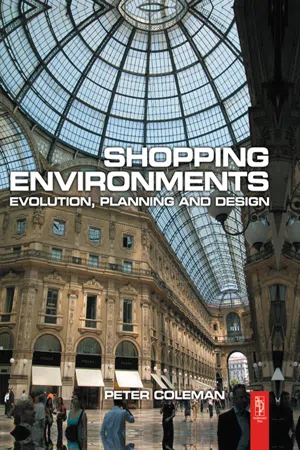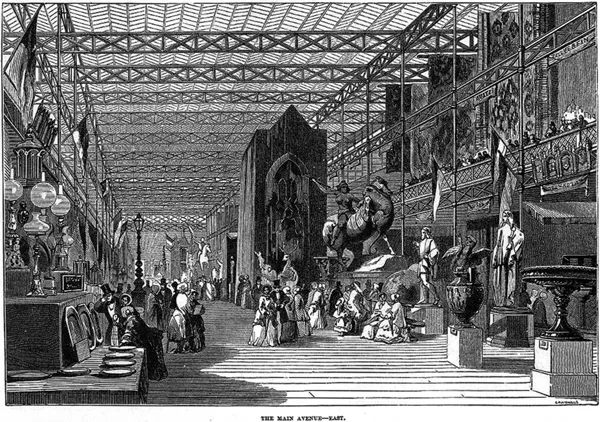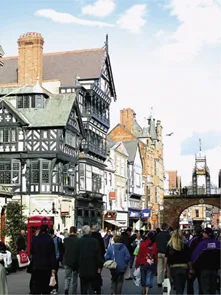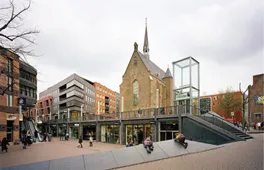
- 472 pages
- English
- ePUB (mobile friendly)
- Available on iOS & Android
eBook - ePub
Shopping Environments
About this book
Shopping centers have become the most common of shopping environments and have influenced the make-up of cities around the world. However, in recent years, the enclosed "mall" has evolved and diversified with new types of retail environments that were developed to better suit their locale and meet public expectation.
This design guide has over 600 illustrations that present the core values and considerations that make a successful retail center: location, catchment user needs, as well as access and layout. Covering everything from site master planning to the essentials of public facilities and the technical systems, this is essential reading for architects of contemporary shopping centers.
A series of international examples showcasing different types of shopping environments are included to cover the wide range of designs that have occurred in recent years. From the "out of town" mall to retail parks and mixed use town center developments, the best of contemporary design is illustrated to provide both practical information and inspiration.
Frequently asked questions
Yes, you can cancel anytime from the Subscription tab in your account settings on the Perlego website. Your subscription will stay active until the end of your current billing period. Learn how to cancel your subscription.
At the moment all of our mobile-responsive ePub books are available to download via the app. Most of our PDFs are also available to download and we're working on making the final remaining ones downloadable now. Learn more here.
Perlego offers two plans: Essential and Complete
- Essential is ideal for learners and professionals who enjoy exploring a wide range of subjects. Access the Essential Library with 800,000+ trusted titles and best-sellers across business, personal growth, and the humanities. Includes unlimited reading time and Standard Read Aloud voice.
- Complete: Perfect for advanced learners and researchers needing full, unrestricted access. Unlock 1.4M+ books across hundreds of subjects, including academic and specialized titles. The Complete Plan also includes advanced features like Premium Read Aloud and Research Assistant.
We are an online textbook subscription service, where you can get access to an entire online library for less than the price of a single book per month. With over 1 million books across 1000+ topics, we’ve got you covered! Learn more here.
Look out for the read-aloud symbol on your next book to see if you can listen to it. The read-aloud tool reads text aloud for you, highlighting the text as it is being read. You can pause it, speed it up and slow it down. Learn more here.
Yes! You can use the Perlego app on both iOS or Android devices to read anytime, anywhere — even offline. Perfect for commutes or when you’re on the go.
Please note we cannot support devices running on iOS 13 and Android 7 or earlier. Learn more about using the app.
Please note we cannot support devices running on iOS 13 and Android 7 or earlier. Learn more about using the app.
Yes, you can access Shopping Environments by Peter Coleman in PDF and/or ePUB format, as well as other popular books in Architecture & Architecture General. We have over one million books available in our catalogue for you to explore.
Information
PART 1
The Development and Nature of Shopping Environments
1
The Big Issues
Issues Facing Shopping Centres Today
As we enter the 21st century there are new challenges facing designers with the continual emergence of new types of shopping facility. New urban types of shopping facilities prevail today which are designed as integral parts of our town centres, combining traditional high street qualities with the commercial efficiency, convenience and operational benefits of a planned shopping facility. These new types challenge the conventions and preconceptions of existing shopping centres to the point where new criteria and new types of centre emerge.
Each new type of shopping centre that emerges does not replace the existing formats of shopping, but adds to the diverse range of shopping facilities that already exist. This reinvention and diversification are further reflections of the dynamic nature of this building type.
Many different types of shopping facility already exist. These can be defined by product (e.g. white goods shops and fashion) and by places (e.g. by type of environment, whether its in town, out-of-town or a retail park). Despite this vast range of facility there is a public wish for more interesting and more unique types of shopping environment.
Before going on to examine how shopping centres are created and designed, it is necessary to achieve a general understanding of their nature, together with an awareness of the big issues facing those involved with forming a shopping centre development.
This chapter gives an overview of the dynamic nature and complexity of shopping centres and examines the issues facing the industry. These issues are examined in three strands: social; plan-ning; and retail economics. The chapter concludes with the recognition that reinvention and diversification will continue as these key challenges are addressed.
Shopping facilities are an expression of a market. Fundamentally, they provide a showcase for manufacturers to sell their wares. They are part of a large, sophisticated and dynamic industry tied into the economy of a country, its regions and districts. They also reflect basic human activities, such as consuming and trading. They have been integral to our settlements from earliest times and have grown at the heart of our towns and cities. Basic trading stalls in markets have grown into the various shopping formats we have today. The development of the different types of contemporary shopping environment is examined in detail in Part 2 of the book (Fig. 1.1).

Figure 1.1 The Grand Exposition/Crystal Palace – a showcase for manufacturers to sell their wares. (Source: Dover Publications)
Those employed in the retail industry make up a large proportion of a country’s workforce. In the UK, for example, 20 per cent of the workforce is employed in the retail industry (British Council of Shopping Centres Report, 2001). This makes the retail industry the second largest employer in the country, only marginally exceeded by a declining manufacturing industry. This figure does not include the many consultants and development teams involved in creating and bringing together the shopping centre, nor those who build them.
Retail property is one of the most important investment categories in the UK. Plans in the pipeline to meet a demand for 11millionm2 (119millionft2) of new floor space by 2012 ensure this is likely to continue for the foreseeable future (British Council of Shopping Centres Report, 2001).
Shops generally form the heart of a town or city centre. They affect our environment and become the places we identify with, serving as backgrounds to our social and leisure lives. They often form the memories we grow up with and look back on as pleasant parts of our lives (Fig. 1.2).

Figure 1.2 Town centres form the heart and backdrop to a community’s social life, illustrated by Eastgate Street, Chester, UK. (Source: Peter Coleman)
In the planning and design of shopping environments, consideration needs to be given to the great number of visitors passing through the centre each day. In the largest centres at weekends this volume can be over 100000 visitors a day and can reach several hundred thousands per week. Only major football stadiums and some of the largest railway stations and airports achieve a similar footfall. In addition to the shopping public that must be catered for, shopping centres employ large numbers of staff who run the shops, numbering from 3000 to 5000 people, depending on the size of centre, and they require facilities as well.
Retail centres generate large traffic volumes derived from public access to the shops, and from servicing, including private and commercial service vehicles. Public transport serving shopping centres needs to be integrated and made applicable and relevant, available and accessible to those who are likely to use it. All these people – and goodsmoving factors – must be considered and accommodated into the surrounding highway and transport network.
Although shops can be the sole use, they are more usually grafted into a mix with other complementary uses such as food consumption and, increasingly, with leisure facilities, creating a broad spectrum of consumer use. Shopping facilities are changing in nature, with more activities and uses incorporated into them. Over a third of all new developments considered in 2002 included a significant leisure element. Now, with more town centre schemes in the pipeline involving the new urban type of shopping environment, this format is often a mixed-use development requiring an understanding of other building types such as housing, offices, transport hubs and civic buildings. These mixed-use developments require design skills, which include the different building types, town planning and public realm design capabilities.
The key issues governing design and development of shopping centres fall into three main areas: 1 social and human 2 planning 3 retail economics.

Figure 1.3 A new urban community featuring a library, church, housing and shops, Marienburg, Nijmegen, The Netherlands (2000). (Source: Peter Coleman)
Social and Human Issues
Public sentiment is potentially the single most important factor that designers need to consider. Although there is a need for comfort – including protection from bad weather – and security, there is also a need for convenience, especially ease of access both by car and public transport. Although shopping centres in the past met many of these criteria, recent focus group research indicates that the public has a dislike for enclosed, internalised shopping environments and would prefer to go shopping in more natural environments where there is daylight, a feeling of contact with the outside and something unique or particular about that town or city. Public opinion has expressed a preference and a wish for arcades, market halls and even simple glazing covering existing streets. There seems, therefore, to be a difference between what the public prefers and what development world has traditionally been providing in the form of interior based shopping environments.
This shift in public feeling, together with planning requirements, which are also moving in the same direction, presents one of the greatest challenges to designers of shopping environments. It seems, therefore, we have reached a key moment in time, in that any scheme that is now presented has to take on board these new criteria and most shopping facilities will have to address the urban agenda.
Society today finds itself with a shortage of time. And time, together with attention and trust, have been categorised as the ‘new scarcities’ (Dr David Lewis at the British Council of Shopping Centres Conference, 2002). The scarcity of time is one of the results of modern day pressure-cooker living and fast lifestyles. When people use some of their scarce time to go shopping they expect the right retail offer and the right level of amenity and comfort.
The British Council of Shopping Centres Report, Shopping Centre Futures, identifies that people also have shorter attention spans. (...
Table of contents
- Cover Page
- Half Title Page
- Title Page
- Copyright Page
- Table of Contents
- Foreword
- Preface
- Acknowledgements
- Figure Credits
- Biography
- Part 1 The Development and Nature of Shopping Environments
- Part 2 The Contemporary Types of Shopping Centre
- Part 3 The Design Guides
- Index